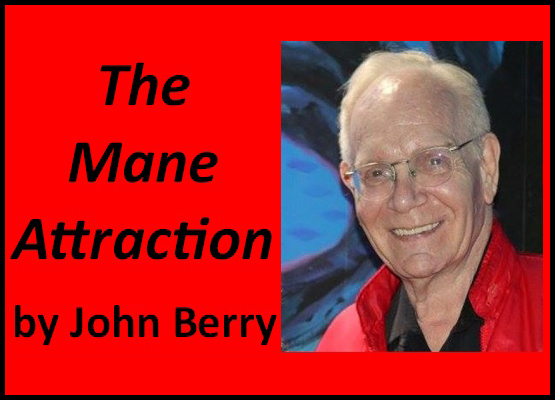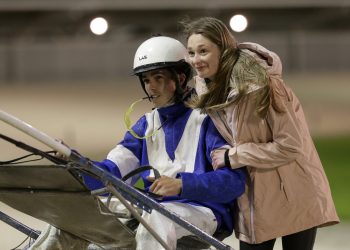All of us begin to think about the inevitable as we age.
Every day, the sun peeks above the horizon to start the day and, hours later, the sun sets as we close our eyes to rest.
 One day, the sun will set on our lives, and we will close our eyes with no sunrise to follow.
One day, the sun will set on our lives, and we will close our eyes with no sunrise to follow.
I think about that often these days.
I am not afraid.
The beautiful article that Kim (Rinker) did about me was appreciated…but a bit embarrassing.
I was raised to be humble and, as a writer, I much prefer to write about the accolades of others and our sport.
I love to make readers see the greatness in others.
As Kim wrote, my first writing appeared in the Horseman and Fair World in their February 4, 1964 edition, ironically, the very night Pompano Park opened for pari-mutuel racing.
That’s almost 60 years ago!
So, what’s the significance of that? It made me realize that I, too, have reached the sunset of life…and I am fearful that our sport has reached the same timeframe.
When I see other great sports like baseball, football, basketball, soccer and, even, bowling, I see programs—YOUTH PROGRAMS—enticing the young to participate and develop skills in those various arenas.
From Little League baseball to high school programs in baseball, football and other sports…and colleges luring applicants for their similar sports and, these days, even bowling, education is the key factor in the success of the young and their road to future success in life.
In my high school days, our school, South Shore in Chicago, had a baseball team, football team and bowling team with regularly scheduled events.
Look at the Little League World Series, college football (and all the “bowl games”), basketball (March Madness), swimming, hockey, track and field, etc.
A college will offer as many as two dozen varsity sports—yes 24 sports.
I never realized that 10 pin BOWLING has become so big that over 45 colleges offer this sport as a main attraction complete with coaches and career opportunities.
Harness racing’s Jake and Rosie Huff’s kids—Ryan and Ronnie–are perfect examples, having been lured to Webber International University for their college studies.
I am not seeing that in our sport.
Yes, we do have Carson Conrad (18 years of age) and Marvin Luna (21) and Adarryl Gates (22) and Ryder Skinner (16) and Jeremy Bobbitt, Joey Putnam, Mitch Cushing and Jordan Patton, all 25, and, I am sure, others, but we are hard pressed to find drivers and trainers in their teens and early 20’s that can carry on the great tradition of our sport that want to have harness racing as their lifetime vocation.
Yes, we have the United States Harness Writers Association Clyde Hirt Workshop…and that is great, no doubt about it, but that covers just a handful of days—not really conducive for developing a lifelong commitment to harness racing, but some of their graduates have made careers in our sport, but never enough.
And since the newspaper business has all but disappeared, there are no more journalists like Mike Lee, Bob Zellner, Leonard Cohen, Ed Binneweg, Bill Brown, Jr., Maury May or Murray Janoff these days to cover the sport like a blanket.
Yes, we have Edison Hatter and Jessica Otten and Jessica Hallett, Trey Colbeck, Ace Barnsdale, Nathan Bain and the Heathers—Vitale and Wilder—and Wendy Ross…but we need a thousand more of them to spread the gospel!
The Harness Horse Youth Foundation has been providing young boys and girls with memorable experiences with our great standardbred breed for—do you believe it—almost a half century now with a goal of fostering generations ahead to participate in our industry…and, with one single new person taking up a vocation in harness racing, a dozen new fans in the form of family and friends are “foaled.”
Their summer camps are including hands-on experience from behavior and anatomy to equipment and the different campsites are located at several locations from Ohio to Indiana stretching to places in Virginia, New York, New Jersey and Maine!
We’ve already got a “bit” of a head start with the Gaskin Stable and DeLong Stable participating and several fairgrounds and farms in the fold so all we really need is to take some larger “strides” to make this happen.
We need a curriculum targeted to high school students and stretching to the two-year-colleges about the standardbred horse and careers in caretaking, training and driving covering everything from the anatomy of the horse to becoming successful in an industry that can afford a lifelong, great career.
We need successful trainers and drivers to help develop these programs and approach schools to offer classes—either at the school or at a track—with employment opportunities waiting after “graduation” with decent pay and a future. After all, not everyone is college material in the fields of law, medicine, technology, anthropology and whatever “ologies” that require 4.0 grade averages to get in the doors.
We need programs to entice our young to put their artistic talent to use with competition with age brackets seeking works of art focusing on the standardbred horse with scholarships awarded for the best works submitted followed by an auction with proceeds going to the aftercare of our standardbreds after retirement.
These programs are, without doubt, necessary and doable…if we can get some of our participants to step up to the plate and, instead of looking at today, look and the 50 years of tomorrows that lie ahead.
Then, we need to flood the market from publications to television stations to podcasts about these programs and featuring the winners of the competition and their aspirations in our harness racing sport.
Just as the water is slowly evaporating from our rivers, lakes and oceans from global warming, our sport is getting eerily similar as the attrition of our fan base, owners, trainers and drivers are having the same effect with imperceptible evaporation.
We see comparison maps all the time showing the evaporation and shrinkage of glaciers and lakes and rivers over the past 30 or 40 years.
If you put up comparison maps of tracks in operation 30 or 40 years ago, you’d find them, again, eerily similar.
I fully realize that change is inevitable in our world but that doesn’t mean that we should ignore change and do nothing about it.
We’ve seen what is happening by being lethargic about global warming and its effect on us…but the longer we wait, the more people it will affect and, all of a sudden, harness racing will suffer from its own form of disaster.
I completely understand why any and every trainer-driver is only worried about the next 1:50 but it only takes one false step to crush the dream.
That’s bad enough…but let’s not have that happen to our entire sport.
by John Berry, for Harnesslink

 USA
USA Canada
Canada Australia
Australia New Zealand
New Zealand Europe
Europe UK / IRE
UK / IRE



